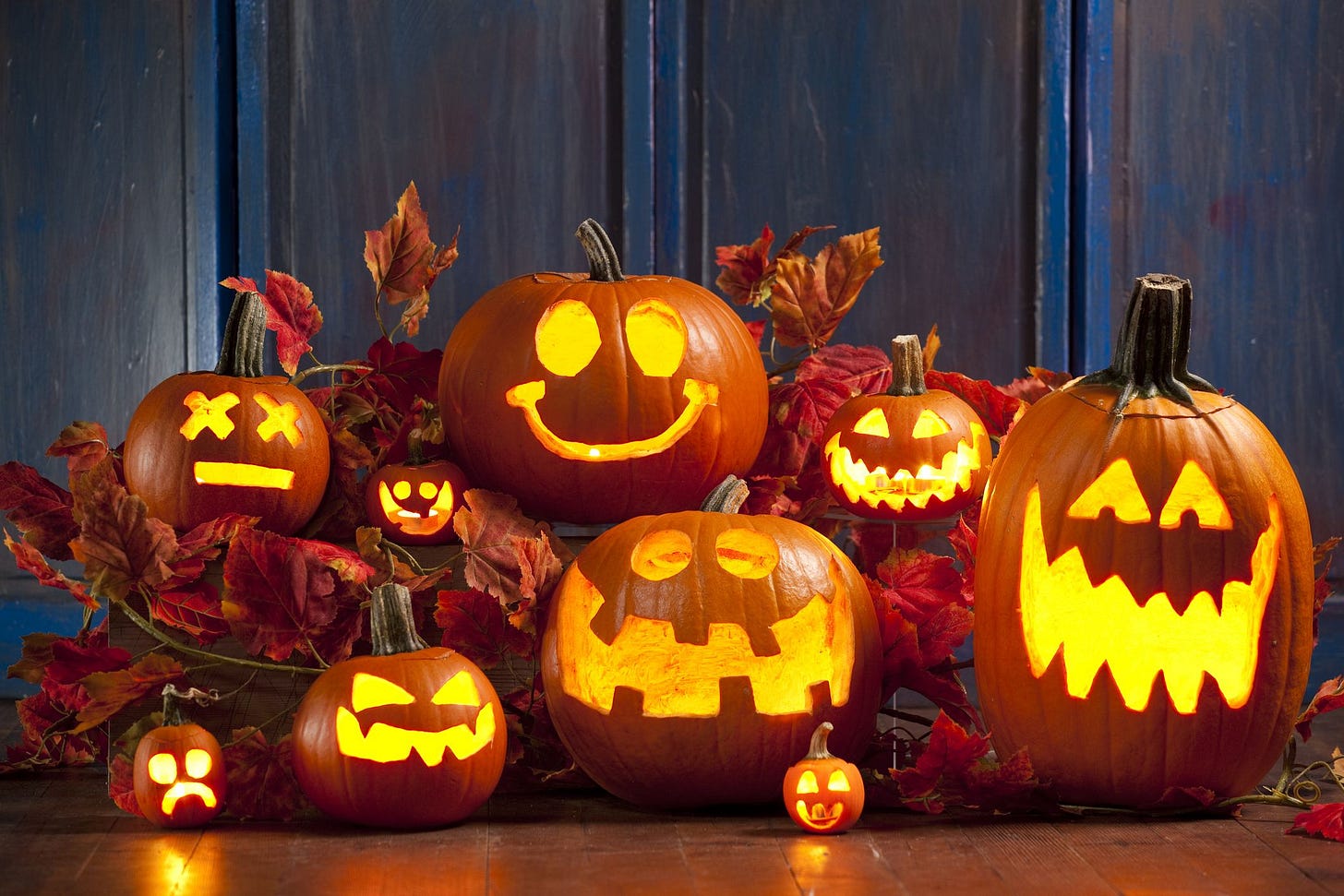ISSUE 009
IN SITU this week discusses the deepening impact of Halloween on the UK cultural calendar, and why nothing beats doing your own consumer research.
IN SITU is a platform dedicated to the intersection between culture, brand strategy and music. Sometimes the focus will be on one strand more than another, but always sitting in that sweet spot.
ISSUE 009 AT A GLANCE
LONG READ Cultural observation opinion piece: The month of Halloween: How we’ve come to embrace spooky season in the UK
VERBATIM Quote from cultural tastemaker: Kyshon Currid-Goode, Account Manager at Broadwick Studio
SHORT READ Belief relating to strategy and/or insight: Core belief #9: Second-hand data delivers second-rate results
MUSIC CORNER Album recommendation: Jamilah Barry - Full Circle
LONG READ
THE MONTH OF HALLOWEEN: HOW WE’VE COME TO EMBRACE SPOOKY SEASON IN THE UK
Halloween is creeping up on us Brits more and more each year. A holiday that rivals Christmas in the US for seasonal decoration, parties & food, it used to be mainly for kids in the UK. Trick-or-treating, scary costumes and themed sweets was pretty much the extent of it, plus a few haunted houses and parties.
But these days we’ve got entire supermarket aisles dedicated to the spooky season, more houses decorated like a theme park attractions, and shop windows featuring pumpkins, cobwebs and spiders.
 Tiktok failed to load.
Tiktok failed to load.Enable 3rd party cookies or use another browser
While working on a research project for Morrisons roughly 10 years ago, which involved spending full days in-store, I noticed Halloween-themed Mr. Kipling cakes. I was shocked. This was a seasonal item that went beyond chocolate eyeballs and themed Haribo, and although still confectionary, a lemon slice is not something you chuck in a plastic pumpkin for trick-or-treaters.
Back in those days, there was no Halloween aisle - these treats were stocked next to the ordinary Mr. Kipling cakes. But having visited a Waitrose over a month ago, there was already one aisle dedicated to Halloween complete with a big sign, and Tesco.com has an entire ‘House of Halloween’ section with all the expected items alongside themed door mats, candles and even bedding.
A recent YouGov poll has uncovered that 41% of Brits say Halloween is more important than other holidays to them and their family, mostly coming from 25-34 year olds. For those who indulge in this ghoulish time of year, the most popular activities are pumpkin carving (27%), home decorating (23%) and watching Halloween themed TV/films (23%). Perhaps surprisingly, trick-or-treating is at 20%, while wearing costumes is at 18% (I’m sure the results would skew heavily in a different direction if only kids were asked).
However, half of those surveyed don’t participate in Halloween at all. In fact, most marketers agree that Halloween is still hugely untapped in the UK, and it will only keep growing. It seems as though you lean in or you completely avoid it - there isn’t much middle ground.
Is this just a marketing play to release seasonal products and content for more high points in the year, or is there more to it? Brands are simply responding to consumer demand, some of which they have nurtured over time, some of which is created by our American cousins, and some is likely down to the natural time of year.
Consumers are looking for something to raise their spirits (no pun intended) because this is a natural dip. We are exactly 2 months from the end of summer, and 2 months until Christmas. The days are shorter, the temperature has dropped, and the next holidays are a long way off. There’s also the less than desirable socio-economic situation, with austerity measures ramping up. Simply put, we need to have fun!
Perhaps Halloween is what’s been missing from the British cultural calendar all along. There are no family or religious commitments, no gift-giving rituals, no rules and no age limits in either direction. Once brand fuel was added to the bonfire, no wonder it’s raged the way it has - it’s the perfect antidote to a seasonal low point. Escaping reality by getting lost in a world of confectionary, cobwebs and costumes - not just for one day, but for a whole month.
You might be thinking, but we have bonfire night on 5th November, so why hasn’t that ‘blown up’ in the same way? Firstly, Guy Fawkes is unique to the UK, which means the total audience is a fraction of Halloween’s.
Secondly, there is no legend or lore with the origins of Guy Fawkes Night. This is a not-so-ancient historic event that is marked with fireworks and bonfires across the country. Unlike Halloween where there is endless creative conjecture, 5th November has a rather limited narrative.
Thirdly, there is no other place from which to adopt rituals, and even less of a reason (or angle) for brands to get involved. We are a small island not known for theatrics, so when no one else has cause to celebrate, we don’t make a fuss.
Zooming out from Halloween it begs the question, why is seasonality suddenly so perennial? We hop from New Years’ into Valentine’s Day and Shrove Tuesday, which leads neatly into Mother’s Day. Then there’s Easter and a few May Bank Holidays, before Father’s Day and Pride in June. July and August are full of barbecues, holidays and festivals, while September is back to school and now, dovetailing into Halloween month. Guy Fawkes kicks off November, and Christmas has a long lead time, taking us until the year’s end. Not to mention a huge number of non-CofE religious holidays, sporting events and one-off spectacles. It’s exhausting just thinking about it!
The increased intensity of these milestones can be boiled down to three reasons:
BRANDS NEED NEW NEWS: It’s tough to cut through, and cultural events give brands a reason to say something new, or at least put a twist on their usual comms and products.
CONSUMERS CRAVE FUN: In our post-pandemic world, we are on the look out for things to peak our interest and encourage curiousty. Whether this stems from brands, content creators or the natural change of the seasons, we’re used to our environment offering stimulus to respond to.
TIME MOVES QUICKLY: The rhythm of our calendars has changed. We’re used to a hyper-rapid news cycle, from all over the world, from multiple sources. So it makes sense that we roll through these milestones at pace, always looking to what’s next on the horizon.
There’s only so many seasonal treats one can take, so maybe we should embrace this ‘holiday creep’. It contains the other seasonal aisles to their corner of the calendar, and allows us to inject some creative freedom into a holiday focused on entertainment. I personally don’t mind fewer mince pies on the shelves in October if it means a few more pumpkin-shaped cakes in September.
VERBATIM
WHAT MAKES HALLOWEEN STAND OUT IN THE CULTURAL CALENDAR?
Kyshon Currid-Goode, Account Manager at Broadwick Studio
“It’s a moment to come together and celebrate your creativity as much or as little as you want to. Regardless of how much you put into it, you can still have a lot of fun.
Within retail, whether it’s clothing or food, it does give brands an opportunity to push certain products. However, it doesn’t feel as brash as Christmas, which is more consumer-centric and actually reduces the ‘fun’ element. Christmas comes with so many rules and traditions, you’ve got to stick to a playbook.
Halloween is more accessible, whether it’s a little face paint, a pumpkin or a witch’s hat, people are taking more ownership over how they want to engage with it. You can really unleash your own self-expression.”
SHORT READ
CORE BELIEF #9: SECOND-HAND DATA DELIVERS SECOND-RATE RESULTS
You can’t fix your challenges with other people’s research. You might find data online that appears useful and answers a few questions, but it’s never going to truly solve the problem you’re having.
With your own research, you control the variables to suit your specific needs. Whether that’s consumer demographics, geography, sample size or especially, methodology, it’s both an art and a science designing research to fit a brief. Primary research created specifically for your brand and your market is worth a thousand online reports, and will save you money (and headaches) in the long-term.
MUSIC CORNER
JAMILAH BARRY - FULL CIRCLE
Barry describes this project as “A very clear depiction and reflection of the full circle moments I’ve had in my life.” The first full-length release since ‘Romance Me’ in 2020, this gives fans an insight into what Barry’s been ruminating and working on in the 4 year gap, although a few tracks had single releases.
An independent artist, Barry isn’t held by any label expectations for what her music should or shouldn’t sound like. She describes ‘Full Circle’ as “100% genreless”, but there a deep, soulful feel to every track, as is constant in her music - always full of life, always full of resonance.
Don’t forget to follow IN SITU on Instagram @insitu.njd, and check out my website at nicolajdavies.com.





